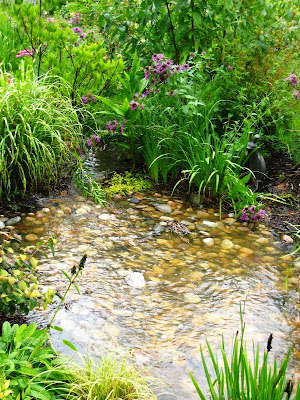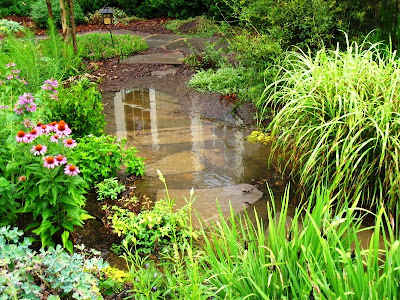We had horizontal rain and hail falling during one storm. The wind and rain blew over a few tall buddleia and flattened some monarda, but I believe that all will recover just fine. I will cut back both a bit to lighten the weight of the tops and use 32" high wire edging fence to help corral the plants in an attempt to straighten them up a bit.
Now to the topic of managing heavy rains.
One of the reasons why we have such a large garden is due to the topology of the land around the house and the resulting water runoff after storms. Our house is down a slope from our large open meadow. Before the slope was planted as a flower garden, we had difficulty getting grass to grow and keeping the seed or mulch in place. We had a big problem with erosion on the slope. Our front porch faces the slope and the spotty grass and mostly dirt areas weren't appealing at all. Also, during the first few heavy rains after our house was built, sections of our driveway almost washed away.
When you have lemons, you make lemonade, right?
What was a problem is now a garden in progress. Here's a view of the front section of outer garden showing the meadow at the top and the stepping stones at the bottom. After a heavy rain, those stepping stones and the plants at the bottom can be 4-6" inches under water.

If you've been following my blogs, you know that I have planted for drought tolerance and deer resistance in my outer garden (outside the fence). I've also had to deal with the times when we have heavy rains and select plants that work well in moist/wet situations, but don't die out in a drought. At the bottom of the slope, I have planted the following perennials and shrubs that can tolerate a few inches of water that slowly drains away after a storm. I refer to this as my rain garden.
Japanese iris
Siberian iris
Iris pseudocorus
Amsonia hubrichtii
Ascelpias incarnata
Lysimachia nummularia aurea
Monarda
Echinacea 'Ruby Star'
Eupatorium coelestinum Wayside
Salvia ulignosia
Nepeta subsessillis
Canna
Itea virginica 'Little Henry'
Illicium
Nieremberia 'Purple Robes'
Carex 'Gold Fountains'
Miscanthus 'Little Zebra'
Additionally, all of the above plants survived last year's drought with minimal supplemental drip irrigation. The only spring/summer deer damage came from a few bloom nibbles on the Japanese irises. The illicium can get stripped by the deer in winter, so I put up one of my 32" high edging fences around it in the winter.
The next photos show where the water that flows over the stepping stone path and rain garden dumps into the dry streambed. There is also an underground pipe that dumps rain water from our downspouts and water feature overflow into the "pond" section of the dry streambed.


The dry streambed continues along the meadow slope to route water away from the sidewalk path, the guest parking and the driveway. At the intersection with the driveway, an underground pipe routes the water underneath and downhill toward a natural creek on our property. The stones slow down the water flow to help it seep into the garden, filter the water and prevent erosion. Since the runoff drains into our natural creek, we use only safe, organic products in our garden.


The plants along the banks of the dry streambed that aren't moisture-lovers are planted high enough to keep them out of any deep water. Some of those include lavender and buddleia, planted high and dry on mounds.
Building the dry streambed took three of us one Saturday morning. We already had a shallow ditch that we just scraped down a few inches more and put a bit of gradual slope down toward the driveway drain. We piled the extra soil to the sides to heighten the banks to contain and narrow the water flow and create planting areas. We laid down permeable landscape fabric before placing the stones -- the ONLY time that I like to use the stuff is with hardscape. We had a pallet of river rock delivered right beside the area to save our backs. My husband, one son and I used a wheelbarrow to dump the rocks into the area. I took a little bit of time to arrange the rocks. We could have created a more scenic scape by including a few larger rocks. However, since we already have a water feature (waterfall and stream), we did a simple dry streambed.
Some of the irises, monarda, amsonia and creeping jenny (lysmachia) are literally planted in the streambed. We cut out sections of the landscape fabric where we planted the perennials.
Here are some photos of the rain garden and dry streambed just after one of the weekend thunderstorms. The water was literally moving, but enough is retained in the rain garden to slowly seep into the soil with the excess being filtered and slowed by the dry streambed.
Our driveway and front walk remain safe during a gully washer because of this rain management. As necessary, my husband does go out to clear any clogs in the drain that goes under the driveway. There is a box junction in the ground there with a drain grate on top. We used concrete around the junction box to ensure that the water ends up in the drain and doesn't erode the soil.





Further up the front outer garden, the corner at the willow is an intersection where the path turns back around the east side of the house past the butterfly garden that is also planted on a slope. The butterfly garden also has a rain garden that channels runoff down the same front stepping stones and into the dry streambed.

Rain management can be used to enhance your garden, protect your property and turn eyesores into pretty areas. The right plants will be happy! It's all about gardening WITH nature -- zone, rain, drought, deer, rabbits -- instead of against nature.
Happy gardening!
Cameron



